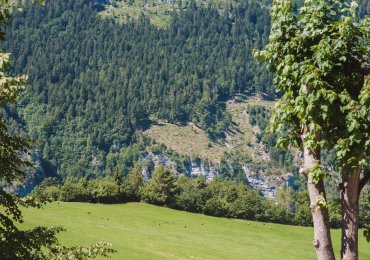-
Why we love it
Because it combines unspoiled nature, scenic beauty, and a powerful ecological message. Walking from Luserna to Lake Lavarone feels like stepping into a living story of Alpine biodiversity. This is a path that doesn’t rush—it invites you to observe, pause, and feel. Every step reveals a new story: a wildflower, a medicinal plant, the hum of a bee quietly at work. - Travelling time: about 3 hours
- Difficulty: Easy
- Length: 12 km
- Total Elevation Gain: 415 m
- Way to travel: on foot, mountain bike, or e-bike.
- Cost: 0 €
- Our Advice: The best time to go is in spring or early summer, when the meadows are blooming and the woods are full of scents. Wear comfortable shoes, bring water, and maybe a pair of binoculars to spot insects and birds. Walk slowly, listen, observe, and respect nature: stay on marked trails and avoid picking flowers or plants. If possible, travel sustainably by using public transport or carpooling. But most of all: experience the trail with a sense of wonder.


This stretch of the Path of the Bees – Bee Trek is an invitation to slow down and let yourself be amazed.
The Bee Garden of Luserna
The route begins in Luserna, one of the most authentic villages in the Alpe Cimbra, where the ancient Cimbrian dialect—similar to German—is still spoken and time seems to pass more slowly.

Right here, just below the historic center, you’ll find the Bee Garden of Luserna, a 500 m² area facing south, where native plants such as fireweed, goat’s beard, raspberry, and early thyme grow. Here, nature takes the lead: wild, resilient, and surprising. This linear garden follows an existing pedestrian path and tells the story of a harmonious dialogue between humans and pollinators.

From the village, the trail leads into Alpine forests, where beech, larch, and fir trees alternate, creating a play of light and shadow. In spring and summer, the undergrowth comes alive with wild herbs and flowers—an ideal haven for bees, butterflies, and other insects.
The route features interactive signs designed to make the experience educational and engaging, especially for children: quizzes, fun facts, questions, and tips on how to help protect biodiversity, step by step.

The Honey Museum
Along the way, you’ll reach the heart of the Bee Trek project: the Honey Museum in Lavarone, just a few steps from the main road. Here, the history of beekeeping comes to life through a collection of over 2,000 artifacts, including antique beehives, natural honeycombs, traditional tools, and rare books. It’s a place that tells the story of bees and their deep connection with humans.

Outside, the Bee Garden of the Museum is a vital space designed to support pollinators, featuring lime, cherry, blackthorn, wild rose, dogwood, and cornelian cherry—planted to ensure continuous blooming and ecological functionality.
The Bee Garden of Lake Lavarone

The final part of the trail gently leads to Lake Lavarone, one of Trentino’s Alpine jewels, nestled among the woods. Here, the Bee Trek reaches one of its most poetic points: the Bee Garden of the Lake. Built on the debris left by storm Vaia, the garden follows a layout inspired by the “waggle dance” that bees use to communicate the location and distance of food sources.

Walking among cluster cherries, corvine pears, wild roses, and meadow sage, you feel as if you're part of a natural choreography—where each plant plays a crucial role in the ecosystem’s balance.

The route ends at the lake’s shore—an ideal place to relax. Crystal-clear water, lush grass, and a rich, intact ecosystem: here, biodiversity can be seen, touched, and heard.

The Bee Trek route map:
Info: Bee Trek
Cover image: photo by Mike Bird via Pexels


